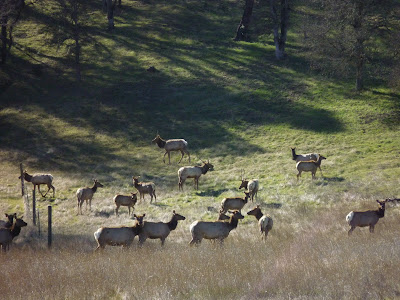 |
| Heteromeles arbutifolia - toyon |
 |
| toyon with manzanita behind |
Also in the jumble was the toyon, with slightly fresher berries. I read in Pippin's tree book that toyon is the only species in its genus, and it grows only in California and Baja California. Though I'd been introduced to Mr. Toyon many times in the last 40 years, I didn't seem to pay much attention to him. I think we'll be friends now. On this occasion I had the time and Google to help me focus and learn more, and I also have a blog where I can find him again if my memory fails.
 |
| another view of toyon |
I did see quite a few of my most beloved manzanitas as well. Manzanita means "little apple." The botanical name arctostaphylos means "bear berry," though of course other animals also feed on these fruits. The common name of some varieties is also bearberry.
Right now the bushes are in bloom (so is the one in my yard); I saw pink- and white-flowered variations. There are about 60 species total, and most of those are native to California, so it's a hard one to pin down as to which species you are seeing.
 |
| manzanita |
Many of the trees I saw on this outing are growing on the slopes of that volcanic mountain I told about before, Mt. Saint Helena, in Napa County. On the weekend scores of cars were parked at the trailhead for hikes up to the top. The spot is in Robert Louis Stevenson State Park, so named because the author and his wife honeymooned on this mountain in 1880. He went on to use it as the model for Spyglass Peak in Treasure Island. One New Year's Day a decade ago our whole family made the trek up and got amazing views.
I left the forest and after driving a while longer I caught a glimpse of something off the highway that made me flip a U across three lanes to go back and take a second look. I was lucky there was a turnout right opposite the meadow where 20 elk were grazing!
Later The Professor told me that he had seen this herd of tule elk many times over the years, in this their winter home; it is the largest migratory elk herd in California. Tule elk are a subspecies of elk only half the size of Roosevelt elk, whose habitat is even more narrow than the toyon: they only live in California. I stumbled through the star thistles and got my socks full of prickles, trying to get as close as possible and watch them for a few minutes before they escaped.
 On the way home I looked and looked for the spot where I'd pulled over three days before, but I couldn't even find the turnout across from the meadow, much less see any animals. If I can get a view of the elk another time or two, I might put them in the category of friends, though they didn't show any signs of wanting to get to know me. So far I'm content to thank God for this happy meeting.
On the way home I looked and looked for the spot where I'd pulled over three days before, but I couldn't even find the turnout across from the meadow, much less see any animals. If I can get a view of the elk another time or two, I might put them in the category of friends, though they didn't show any signs of wanting to get to know me. So far I'm content to thank God for this happy meeting.
6 comments:
"..new every morning... " of course you have more to see and say and discover on the same road. Wonderful. I like the last picture especially.
I have never seen anything like those elk. You live in a truly beautiful and exotic place (at least to this Texan).
Thanks for the manzanita pic!! I grew up visiting family in Oakhurst and saw lots of manzanita. It's a plant I've missed! There is a big 'tule elk reserve' very close by our house. I didn't know they are only in CA. Will have to go check them out.
I love learning about trees. These are all new to me. I remember seeing manzanita in Utah once, but it did not have berries on it then. The Elk are beautiful.
Jody
These are new trees to me - I've enjoyed finding out about them.
I also didn't know that there was a Robert Louis Stevenson connection with California - a bit shameful for a Scot!
Thanks for your toyon comment a couple weeks back. I've put up a new post this morning and linked back to this post of yours.
I, too, have a hard time identifying manzanitas. Calflora lists 115 native species/subspecies of
Arctostaphylos. Good golly.
Hope you have a lovely day!
Post a Comment